Using Competitive Analysis to Spot Potential Threats to Your Business
There are three main phases to developing a good process for proactive threat identification. Read how incorporating competitive analysis can help...
Evaluate the top competitive intelligence tools to find the right one for your business. Get detailed information on the functions, data sources, sales enablement features, win/loss analysis, and more for Kompyte, Crayon, and Klue in our blog post.
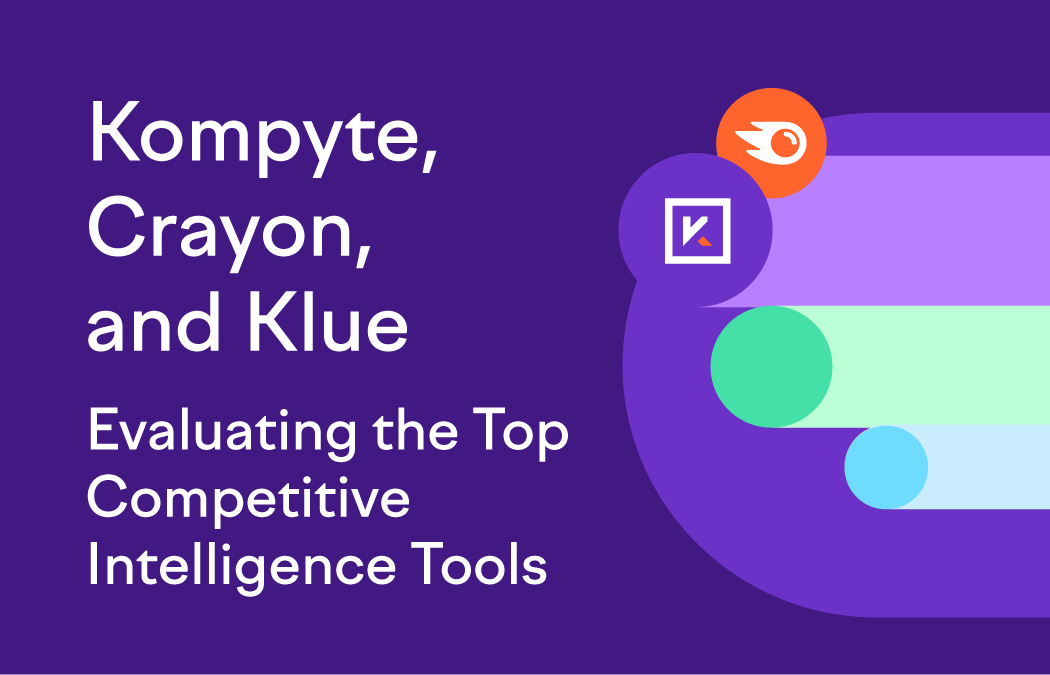
Competitive intelligence is crucial for businesses to stay ahead of their competition and make informed decisions about roadmaps, pricing, and countless other important things. Fortunately, there are many tools available that can help gather, filter, and distribute deal-winning insights about your competitors.
In this blog post, we will compare three of the top competitive intelligence tools: Kompyte, Klue, and Crayon. Each tool has its unique features and benefits, and it can be challenging to choose the right one for your business.
Naturally, we are a bit biased here, but we realize that no one tool is the best tool for every business and every purpose. So, whether you are a small business owner or a large corporation, this post will provide you with the information you need to choose the best competitive intelligence tool for your needs.

Competitive intelligence tools enable you to keep tabs on your competitors without having to visit hundreds or thousands of web pages to compare today’s version to the previous version. We might think of them as having three main functions: data gathering, filtering, and distribution.
How you use the data depends on your business goals, but competitive intelligence insights have the potential to help your sales team win more competitive deals, your marketing team level up their campaigns and messaging, and your product teams to build products that meet the changing needs of your customers.
Historically, competitive intelligence was facilitated by taking screenshots of key website pages and then comparing them in PhotoShop to spot differences. The problems with this method are many, including the fact that not everything not visible will not be in this screenshot (example: drop-down menu options) and that no one can accurately track this across enough competitors and data sources manually to make it useful. For the most part, manual or visual comparisons have been replaced by artificial intelligence.
Let’s have a look at the big three and the reasons you might choose one over the others.
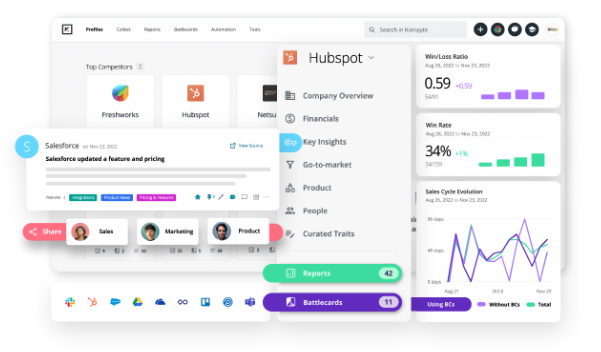
Kompyte visits every website from your competitors as well as every profile - social media, review site, job posting sites, PR news sites - their whole digital footprint once a day as if it was a human. Advanced AI compares the current version with what was there yesterday.
Kompyte classifies each change - whether it’s a press release, pricing feature, new job listing or employee, just as a person’s brain would do automatically. How? We use a supervised model, based on 8 years of tracking websites. We still have a dedicated team that manually classifies parts of different websites to keep the AI learning. Based on human-provided tags, the system creates rules then applies it to other pages. The more we train the model the better we get - and our accuracy rate is already extraordinarily high.
Kompyte then filters all of the noise. Many changes spotted by competitive intelligence tools are irrelevant (think Facebook widgets with like counts that change all the time). Other updates might be relevant for some teams and not others (an A/B test on a landing page, for instance). Kompyte makes it easy to filter updates for different audiences.
Then we curate it in a feed that looks a bit like LinkedIn. We call it the Collect feed. Filters allow users to see only what is useful to them.
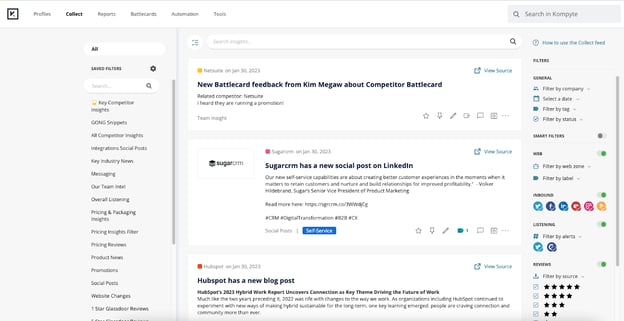
Important data is also available in real time in sales playbooks or “Battlecards,” reports, and as automated updates via email, Slack, or Teams. Kompyte continues to expand integration options.
Kompyte captures over 500 million data points from sources such as:
We know that sales leaders crave consistency. Consistency of messaging and consistency of performance with higher-quality sales engagements. The best way to reach that goal is to have one central place to house all of your competitive intelligence, messaging, and sales outlines and updates in one place - and that place should ideally be inside the tools your sales people already use.
To that end, Kompyte provides flexible playbooks or “Battlecards” that are accessible in HubSpot and Salesforce. Templates and easy drag-and-drop formatting make it easy to customize everything your teams need. All plans include an unlimited number of Battlecards.
Automated insights also come through real time in emails, reports, Slack, Teams, and other channels to keep your teams up-to-date on competitor developments at all times.
Use the two-way integration with Salesforce to effortlessly pull win/loss data directly from there, or easily upload a CSV from your CRM for analysis. Enhance your analysis further by submitting your Win-Loss interviews through Kompyte's InMail feature, and incorporate the results into your Battlecards.
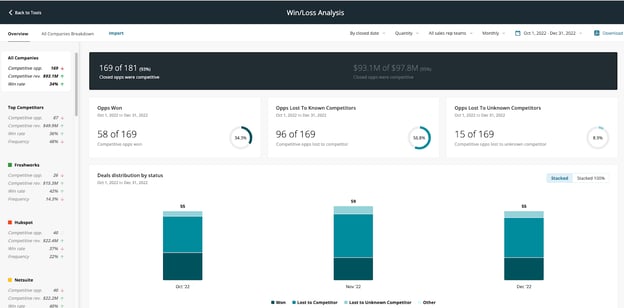
Kompyte’s win/loss analysis shows trends in sales performance and who your toughest competitors really are.
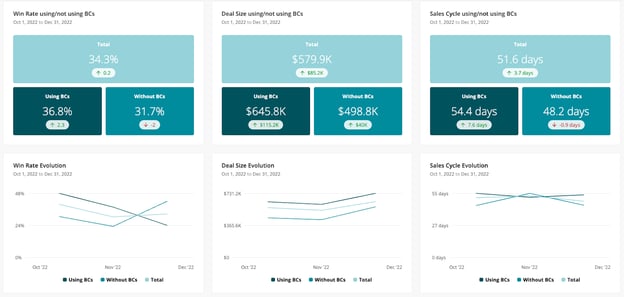
You can also easily see the effectiveness of your competitive intelligence program and how your access changes over time.
No other solution holds a candle to Kompyte’s mature AI. While “new” is usually a good thing in technology, when it comes to AI, you want a system that has been up and learning for a while as they get better over time when well trained. What this means for you is the best data collection and filtering out of all the options, allowing you to enable your teams in about an hour a week.
Our recent acquisition by powerhouse Semrush gives us more resources than ever to build and support what our customers need.
GPT Auto Summarize allows you to get instant takeaways for any insight. Competition moves quickly, but now you'll move even faster! With a single click, get the core details you need. Need to make edits? You can customize the summary to suit your needs, add context, adjust for length, or ask for an entirely new summary with the "regenerate" option. Learn more.
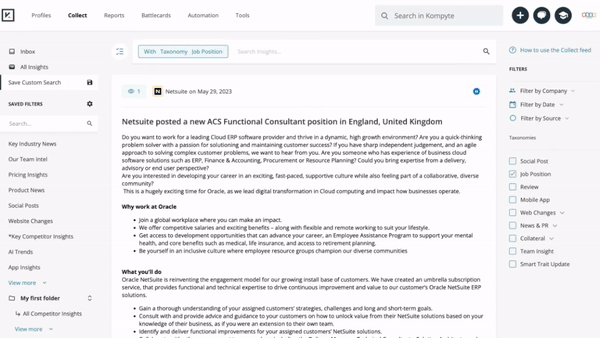
There’s much more to come!
Kompyte appears to be the most affordable option of the three for most users and is based on the number of users and companies tracked. All plans include unlimited Battlecards. There is no charge for integrations.
Those who want to spend less time filtering and curating data but don’t want to miss anything, you want Kompyte. Lightning-fast startup (with no fees), flexibility to add and change competitors, and highly-rated customer success managers who are dedicated to your competitive intelligence program make Kompyte a flexible, comprehensive, and cost-effective choice.
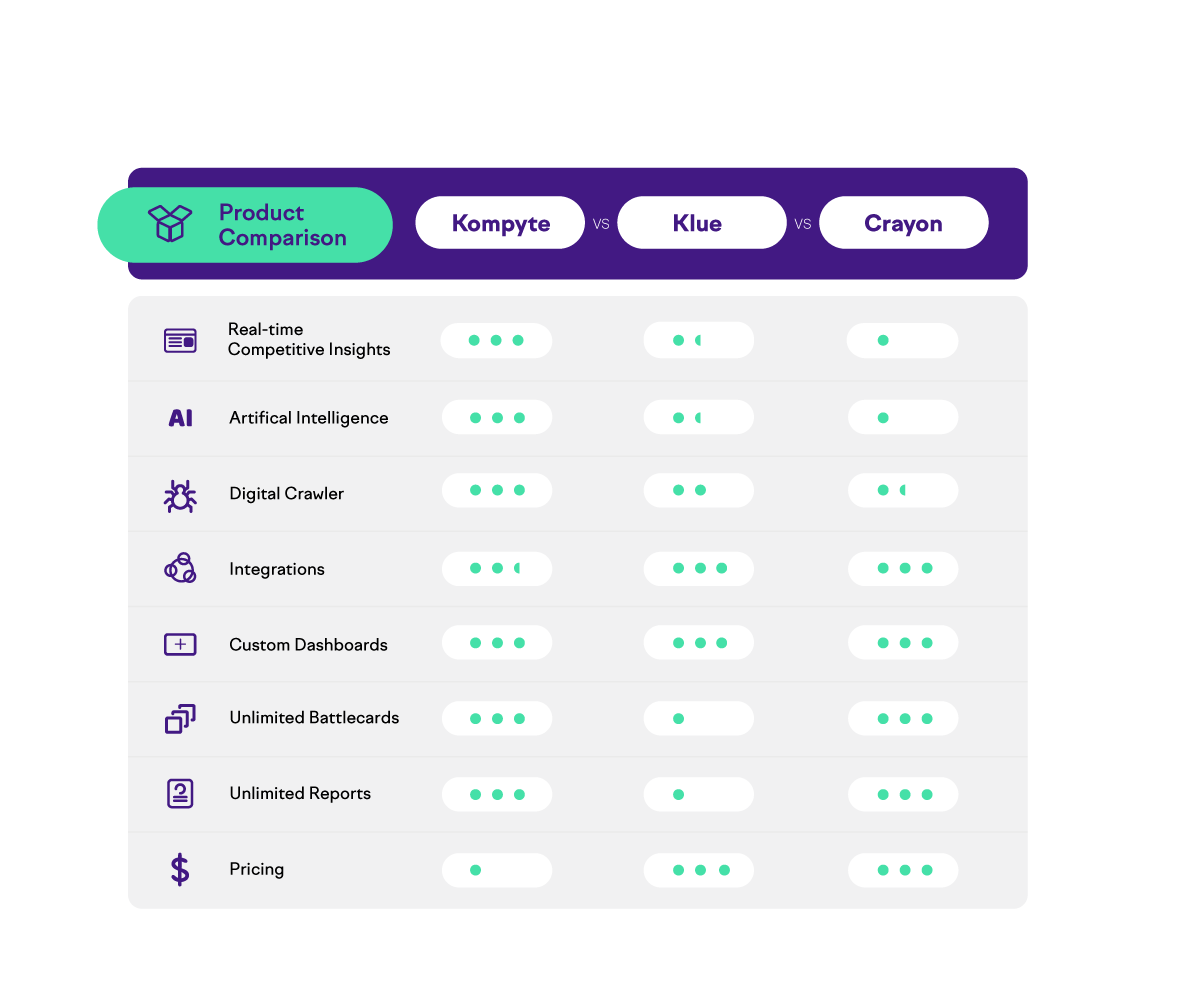
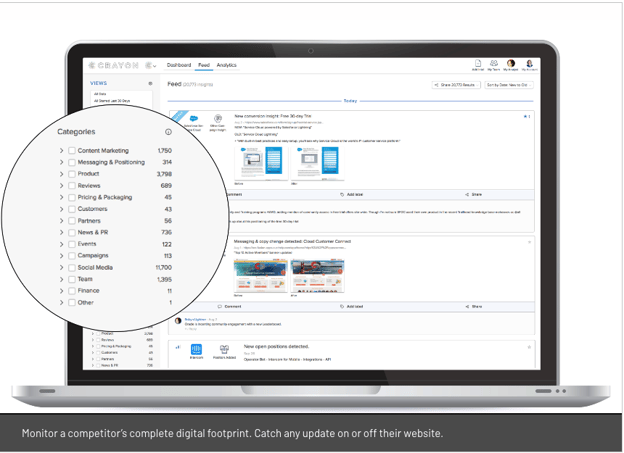
Crayon characterizes itself as a way to help you “understand your competitive environment so your revenue team can more effectively compete”.
As with others in this category, Crayon scours publicly-available online sources of competitor intel, sorting out insights that can be used by all your teams.
Unlike Kompyte, which visits each data source daily, comparing to previous versions and verifying relevance with advanced, AI, Crayon's monitoring is largely based on visual comparisons.
Imagine taking screenshots of 1,000 competitor URLs and visually comparing them to find changes. Key insights can easily be lost due to human error. They have recently introduced an AI component to gather more real-time insights, but still rely on humans to confirm the data, which is normal with early-stage AI programs, but can result in delays. Some reviewers report that they need to do a considerable amount of filtering themselves.
Crayon also allows people across teams to share what they learn about their competitors in a way that’s easily accessible by those who need to know.
Crayon has invested heavily in integrating their product into popular sales tools such as Gong, Slack, Salesforce, etc. meaning your teams don’t need to use yet another software platform in order to use the insights gathered.
Crayon tracks a wide range of data sources including news/PR sites, social media platforms, content sites, review sites, forums, app stores, hiring platforms, and filing sites. There’s no mention of competitor ad or SEO tracking.
All three contenders provide Battlecards, or sales “cheat sheets” to help keep sales messaging consistent and focused. With Crayon, users can create an unlimited number of Battlecards from scratch (no templates are provided and the interface can be clunky, which is noted by reviewers), which is useful for consolidating information for different teams to access quickly.
Automated alerts and shareable newsletters allow for real-time notifications for key insights.
Crayon recently partnered with Primary Intelligence to provide win/loss analysis so you can see to which competitors you're losing deals and show the value of your competitive intelligence program. It also enables automatic import of win-loss interview data to Battlecards.
Crayon wins for time in the market and brand recognition - they are truly the OG. Accounts allow for unlimited users. Their CS team gets high marks in reviews.
Crayon offers summarization for news articles only. Click on “add takeaway” and then “Summarize with AI.”
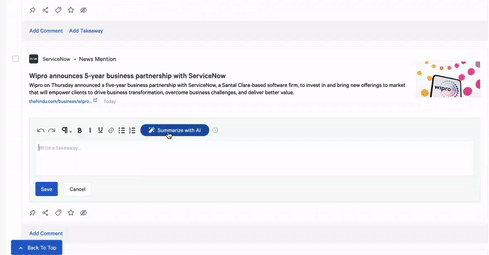
Pricing is not available on their website, but be aware that at this time it appears that they do charge for additional support and changing/adding competitors. As best we can tell, Crayon is the most expensive option of the three. Expect to pay extra to use integrations.
Companies with few competitors to track and no plans to add or change competitors monitored. Because they still use human analysts to process data, scalability is a challenge and adding or even changing competitors on a plan is expensive. You’ll also need to be prepared to wait for initial data as anecdotally we hear that startup usually takes around three weeks.
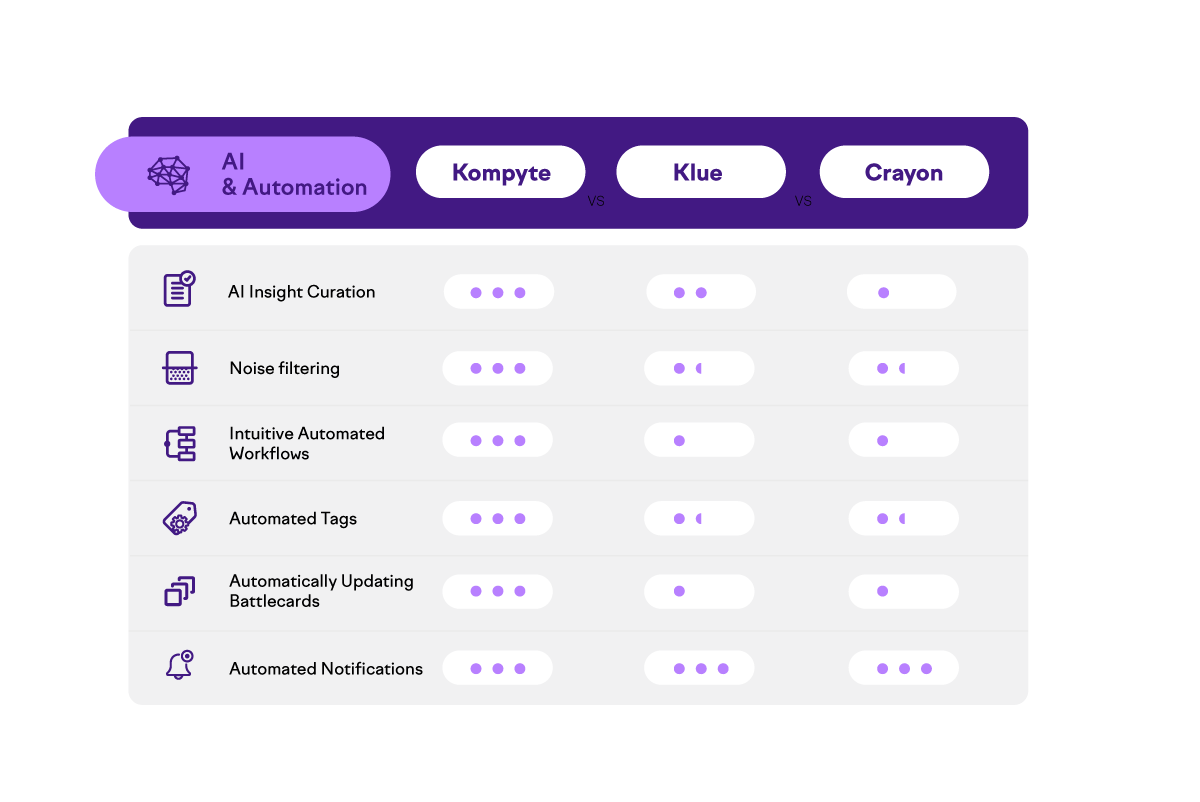
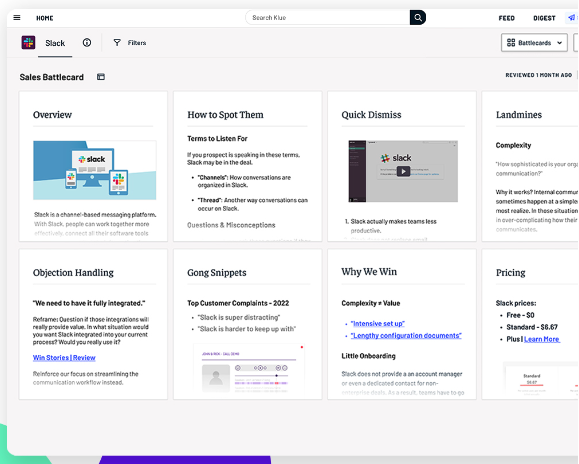
Klue claims to automate “the collection of competitive and market intelligence, streamlines your analysis, and makes it easier to distribute insights and messaging to every team in your organization.”
Klue uses an automated web crawler to find updates to your competitors' data, focusing mainly on news and press release sites. Their artificial intelligence program then verifies the findings and delivers them. Since Klue’s AI is relatively young, insights are not delivered in real time and can generate a considerable amount of noise, though they claim to filter about 87% of the insights collected. Which may explain why some report missing key insights.
As with the other contenders, Klue knows salespeople already have more than enough platforms to work with, so they’ve integrated with popular sales tools to make insights available where the sales team is already working anyway.
According to their website they track, “millions of data points from public sources across the web”, including “website changes, reviews, social media, press mentions, product launches, and more.” Users can also add their own insights.
Klue creates beautiful Battlecards. You can create your own internal digests for sharing insights with your team via Slack, email, or Teams.
Klue recently acquired DoubleCheck, a platform that specializes in providing win-loss data and interview recordings you can search by keyword and tagging. Data can be integrated with Battlecards.
Some users comment on Klue’s Battlecard design. They also have a large number of integrations with commonly-used tools.
Klue can summarize press releases news updates. You can edit the summary and adjust for tone, length, and format.

Pricing is not publicly available, but Klue does charge for setup. Klue charges for curators and consumers with curators being the more expensive role. It is unclear how much additional charge there will be for win-loss analysis. As far as we can tell, Klue falls in between Kompyte and Crayon for pricing. Expect to pay extra to use integrations.
Teams who want to use competitive intelligence for sales enablement only. Product and marketing teams will prefer Kompyte or Crayon for better coverage of data sources. You’ll want to have someone dedicated to the fairly intense setup process and to curate data as it comes in.
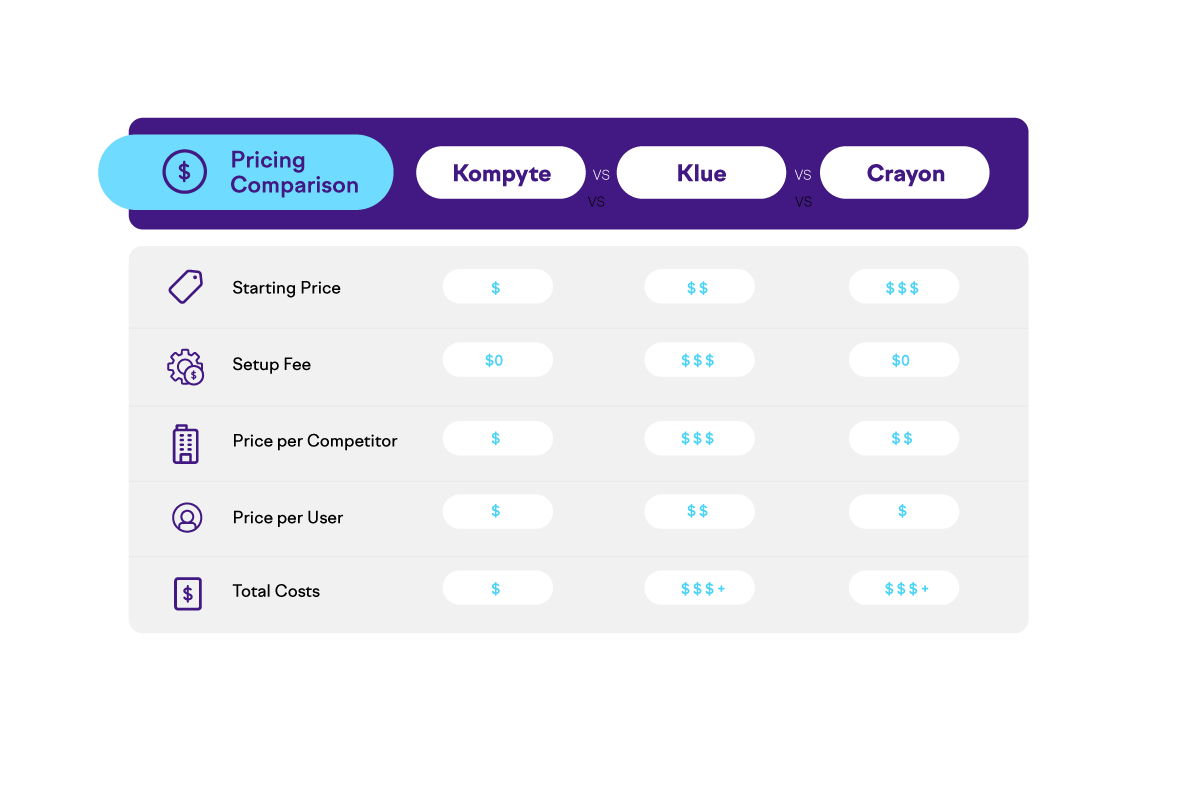
In conclusion, when it comes to choosing a top competitive intelligence tool, Kompyte, Klue, and Crayon are among the best in the market. However, Kompyte stands out with its unique features such as real-time website monitoring, the most powerful AI in the business, and actionable insights. Kompyte's user-friendly interface, robust win/loss analytics, and ability to integrate with popular tools like HubSpot, Salesforce, Teams, Slack, and more, make it a top choice for businesses looking to stay ahead of the competition. If you're in the market for a competitive intelligence tool, Kompyte might just be the right choice for you.
There are three main phases to developing a good process for proactive threat identification. Read how incorporating competitive analysis can help...
Find out how to use current CI data to create the right benchmark for the rest of 2020 and beyond.
Kompyte puts competitive intelligence-driven enablement on autopilot for customers with the next evolution of KPHi platform
Be the first to know about new B2B SaaS Marketing insights to build or refine your marketing function with the tools and knowledge of today’s industry.